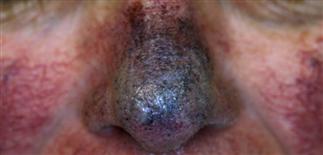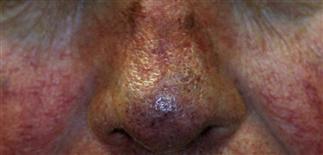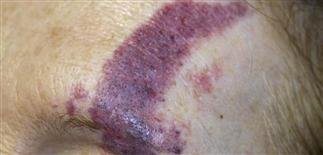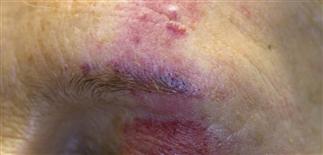166
Lasers in dermatology

Dark red to violaceous telangiectasias over the nose before treatment.

Improvement in telangiectasias after three treatments with the pulsed dye laser.

Long-standing port wine vascular stain on the left forehead before treatment.

Improvements in the port wine vascular stain after two treatments with the pulsed dye laser.
INTRODUCTION
Laser light is, by definition, monochromatic (single wavelength), coherent (waves in phase) and collimated (waves travel in parallel). In the skin, laser energy is absorbed by chromophores, which include water, melanin and oxygenated hemoglobin. Selective photothermolysis is a more specific and targeted laser energy delivery that improves effectiveness and reduces thermal damage and potential scarring. For almost all therapies, multiple treatments are required for full benefit.
USE OF LASERS IN DERMATOLOGY
• Pigmentation. Photopigmentation: lentigoes or solar freckles on sun exposed areas of face and hands. Treatments which can destroy melanin pigment include intense pulsed laser (500–1200 nm) and alexandrite laser (755 nm). • Blood vessels. Facial telangiectasias, rosacea, hemangiomas, port-wine stains. Pulsed dye laser (585–595 nm), best for vascular lesions of all types, may leave some bruising and require several treatments for complete removal, especially with port-wine stains. Nd : YAG laser (1094 nm) also has a role in blood vessel removal, especially spider veins of the legs. • Hair. Alexandrite laser (755 nm), most commonly used for hair follicle destruction, is best on dark hair and light skin. Multiple treatments required. • Tattoo. Dark tattoo inks are easier to remove than lighter colors (light yellow, orange and red). Various lasers may have potential to remove darker tattoo pigments but KTP (532 nm) laser is most useful. • Wrinkles and hytids. Skin tightening and wrinkle removal is achieved due to water acting as a chromophore in the skin. Carbon dioxide laser (10 600 nm), with either conventional or fractionated laser techniques, can heat the dermis quickly, cool relatively fast and stimulate collagen formation in the dermis resulting in tightening and rhytid reduction. • Destruction. Ablation or destruction of skin, tumor or other unwanted growths can also be achieved using water as the chromophore in the skin and an ablative carbon dioxide laser (10 600 nm), however scarring may occur. Can also be used for tumor destruction, actinic cheilitis and other types of benign tumor (e.g. large nevi). • Hair removal in dark skin. Nd : YAG (1064 nm) laser is used to remove dark hair in dark-skinned individuals, especially for those with pseudofolliculitis barbae.
COMPLICATIONS AND LIMITATIONS
Burning and scarring with any type of laser is possible. Pigment change, either hypo- or hyperpigmentation, can occur and depends on the baseline skin color, degree of pigmentation or sun exposure, before and after treatment. Ablation, destruction, or burning of the retinal and iris pigment as well as burning and blistering of darker skin types can also occur.







